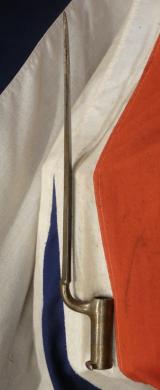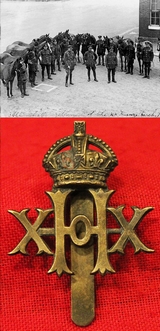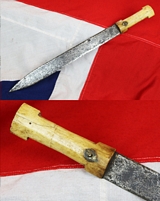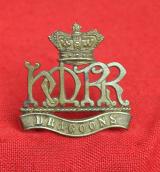Antique Arms & Militaria
After Over 50 Years Here I Am Just as Thrilled With Our Latest 5 Star Review as I Was The First Time, When We First Went Online Over 26 Years Ago In The Year 2 BG {Before Google}. Enjoy Your Online Experience
Not only are we extremely grateful for our fabulous reviews, 5 Star or otherwise, we are also extraordinarily delighted that all the people have gone to the effort to create such kind words, as we never, ever, request reviews from our visitors, it is all entirely and simply down to their kindness, and the valuable time and effort they take out of their lives in order to compose such compliments, within their reviews.
Here is just a sample of past 5 Star Reviews.
Brian
113 reviews·582 photos
Wow ,, this is my favourite shop of all time - my partner spent over an hour trying to get me out of the place - it’s a a sword collectors dream ,, you have to see this place to believe it Fantastic - you could spend all day in there and still miss something.
Response from the owner.
We were delighted for your visit, and thrilled you obviously enjoyed your time here, albeit more briefly than you might have liked. We hope you both make it down here to visit once again, many thanks and kindest regards, Mark
—————————
Emma Field
3 reviews·
I’ve purchased several items from this shop, my favourite being a katana. The brothers that own the shop are very informative and patient. I hope to return very soon. Highly recommend.
Response from the owner
Hi Emma, That is very kind of you to go to the bother to make such a nice review, it is much appreciated We very much look forward to your return, no purchase necessary of course, just to say hi! would be great enough. All the very best wishes, Mark
——————————-
Richard Dundas
15 reviews·2 photos
Incredible shop with an incredible selection of artefacts. There were so many amazing pieces in such a small space.
Response from the owner
Dear Richard, Thank you so much for your kind review and comments. It is always very much appreciated. see you again hopefully. Kind regards, Mark
—————————-
Neil Bolden
17 reviews
Bought a few items over the years. Guaranteed you are buying an authentic item. For my last purchase, Lanes Armoury went out of their way to locate an item l was looking for and l received it within 2 days of payment.
Response from the owner
Many thanks indeed for your most appreciated compliments, and we look forward to assisting you again in the future
———————————
Darcy Lawler
25 reviews·50 photos
Could spend absolutely hours wandering this tiny shop, so much history everytime you looked you saw something new. The two men working there were very friendly and knowledgeable, they were happy to answer any questions and tell stories about the items
Response from the owner
Thank you Darcy for your most kind and complimentary review. It is always a delight to us to know visitors to our shop have enjoyed their visit, it make all our efforts worthwhile. To take the time to review our family business online is also especially kind. Thank you once again.
——————————
John Anthony
Local Guide·77 reviews·53 photos
Great sword shop.
Response from the owner
Dear John, thank you so much for your compliment. It is always very pleasing to know that a local guide enjoyed their visit enough to leave a kind review. Many thanks once more
———————————
Curtis Ramsay
Response from the owner
Dear Curtis, i was delightful to see your Five Star review, it is much appreciated , and many thanks indeed. We are glad you enjoyed your visit
————————————
Chris Corfield
Local Guide·25 reviews
An absolutely amazing shop full of military history! The staff are knowledgeable and friendly. Thanks for your assistance and help with an appraisal.
Response from the owner
What a most kind compliment. we are delighted you enjoyed your visit, and we were most happy to assist you. You will be most welcome back anytime.
Thankyou
———————————-
John Anthony
Local Guide·77 reviews·53 photos
Great sword shop.
Response from the owner
Dear John, thank you so much for your compliment. It is always very pleasing to know that a local guide enjoyed their visit enough to leave a kind review. Many thanks once more
——————————-
steven gibson
1 review
We made our annual pilgrimage to this amazing shop this week, if we lived closer it would certainly be more often! The welcome we always receive from Mark + David is amazing, they are so passionate and knowledgeable about their stock and they will spend as much time as you need explaining the history and relevance of any item you wish to look at, so you know exactly what you are buying. You will be treated in the same way if you are browsing or buying. There have been comments previously about the high prices but when you are buying such a work of art you get what you pay for, and some of these items are museum quality. A well deserved 5*
Response from the owner
Dear Steven, it was delightful to see you both once more, and it was especially nice of you to take the time to make such a wonderful review. it is really very much appreciated. Looking forward to seeing you both next year, take care and many thanks indeed. Mark + David.
Post script, To be fair not everyone goes as high as 5*, as we simply cannot always be all things to all people, however hard we try, but be assured, every effort will be made by us to improve your rating on your next visit. For example we gained just 1 star from one of our oldest and most revered customers, because two years ago he simply he couldn’t get to grips with our ‘new and improved’’ website. So sorry Fred, we are trying our best to improve it for you! read more
Price
on
Request
A Pair Of French, Chassepot Rifle Sword Bayonets. 1870's
Very Good Chassepot Rifle Sword Bayonets. Stunning examples, with very good steel and brass, They could look super displayed just as we show them. The hilts have been polished as could the blades.
Its inventor was, Antoine Alphonse Chassepot, and it became the French service weapon in 1866. It was first used at the battlefield at Mentana, November 1867, where it inflicted severe losses on Garibaldi's troops. The event was reported at the French Parliament: "Les Chassepots ont fait merveille!", {The Chassepots did marvelous execution !} In the Franco-Prussian War (1870-1871) it proved greatly superior to the German Dreyse needle gun, outranging it by 2 to 1. Although it was a smaller caliber but the chassepot ammunition had more gunpowder and thus faster muzzle velocity. The Chassepots were responsible for most of the Prussian and other German casualties during the conflict. This is the most widely copied of all the sword bayonets. Many countries - including the United States, Egypt, Belgium, and Argentina - have manufactured or used very similar bayonets. The French model was designed to fit on the French Model 1866 Chassepot Rifled Infantry Musket (the musket was revolutionary in itself). It was manufactured from 1866 to about 1874 and was replaced by the French Model 1874 "Gras" Bayonet.
The bayonets are brass-hilted The crossguard is iron (steel) and has a screw-type tightening arrangement on the muzzle-ring. The lower quillon is a hooked "blade-breaker" type.
The blade is steel, single-edged, fullered (both sides), with a re-curved or "yataghan-shape." The blades marked on the back-edge (opposite the cutting edge) with the arsenal, month, and year of manufacture; this is done in engraved cursive fashion
Arsenals encountered may be such as Chatellerault, Mutzig, St. Etienne, Paris-Oudry, Tulle, and perhaps Steyr (not confirmed on the 1866). The French wars during the life-span of this bayonet were: French Intervention in Mexico (1861-1867);
Franco-Prussian War (July 19, 1870 - May 10, 1871)
French Indo-China (1873-1874, 1882-1883);
Sino-French War (1883-1885);
Madagascar Wars (1883-1885, 1895);
1st Mandingo-French War (1883-1886);
1st Dahomeyan-French War (1889-1990);
2nd Dahomeyan-French War (1892-1894);
Franco-Siamese War of (1893)
2nd Mandingo-French War (1894-1895);
Conquest of Chad (1897-1914);
3rd Mandingo-French War (1898);
Moroccan War (1907-1912);
The Wadai War (1909-1911);
World War I (early).
These bayonets were widely copied and used by many countries - including the United States, Belgium, and Germany. Many of the actual French-marked bayonets can be found with German manufactured blades. It is believed some of these were used during the American Civil War when many European arsenals were emptied of their surplus arms.
These bayonets are the French Model 1866 "Chassepot" Bayonet.
The crossguard are iron (steel) and with a "cock's comb" muzzle-ring finial. The lower quillon is a hooked "blade-breaker" type.
The blade is steel, single-edged, fullered (both sides), with a re-curved or "yataghan-shape." One blade is marked on the back-edge (opposite the cutting edge) with the arsenal, month, and year of manufacture; this is done in engraved cursive fashion. No scabbards read more
320.00 GBP
Another Original Collection of Ancient Weapons of Antiquity Arrives This Week! Once More, All Manner of Singularly Fine & The Rarest of Intriguing Historical Pieces Recently Added, and To Be Added, Every Day
Recently we have acquired and added all manner of interesting artefacts, both ancient and vintage: Including, an ancient Imperial roman Gladiator's ring 1st century AD, an Imperial Roman Equestris Legion Centurion's seal ring engraved with horse mounted combat. A gold and bronze ancient Chinese crossbow mount, an antique Aztec form sacrificial knife, a stunning Baker Rifle, an Ancient Greek or Spartan senior ranked warrior's ‘stooping horse’ seal ring, around 2600 years old, Ancient Roman Kingdom period {500 bc} centurion armilla, from the earliest era just after Romulus and Remus, a 1700 to 1800 year old Roman Gladiators ring, realistically engraved with a lion attacking a horse in the arena, a superb 1798 ‘Baker’ British rifle’s officer’s rifle, several US Civil War revolvers including Colt Army and Remingtons, a Roman Republic Period status rings and seal rings, Viking warriors bronze pieces, one of the most beautiful American frontier Plains Rifle we have seen now sold, a Native American Chiefs rifle, the same as was used by Chief Sitting Bull at the Little Big Horn, a Remington Rifle captured by a Coldstream Guard at Tel el Kabir {also now sold} a Trafalgar period Royal Naval incendiary cannon ball, an incredibly rare Draken head form Viking ‘magic, staff pommel, A Seiðstafr, The Staff of Power, used by a Viking shaman, plus one of the most amazing Viking Berserker warriors neck torc’s we have ever seen, still wearable condition and a great size, several wondrous Japanese katanas, a very rare type of Zulu War period, assegai spear-knopkerrie combination weapon, a type we have only seen twice before in over 50 years, also, lots, lots more.
Also just recently added, a set of ancient Viking prisoner and slave shackles with lock casing, a fabulous US army contract musket used from the Alamo, through the Mexican American War and also the US Civil War, a crossbow bolt recovered from Agincourt, and a light dragoon pistol of Waterloo.. Also, recently added; a Napoleonic Wars era 60th Rifle Regt. Jäger Rifle, Circa 1800, used by the German rifle volunteers of the British Army. Fine antiquities, as we mentioned last week, have arrived on Monday, including a very fine Viking warriors sword from the siege of Paris era, a 15th century iron handgonne, the very earliest form of hand held gun powder gun from the 1400’s. A ‘ballock dagger’ from the period of King Richard IIIrd, and the Wars of the Roses. A pure gold ancient Roman intaglio carved garnet gemstone seal ring, depicting a profile carving, possibly of Emperor Antoninus Pius, the fourth of the five good emperors, or a similar highest ranking Patrician of Rome, plus, a masterpiece of 23 carat hammered sheet gold, a now assembled ‘Wreath of Conquest’, the head adornment worn by the ancient victors of the games, conquerors and their queens of Greece & Macedon, in the later first millennium B.C. and thus emulated by all the ceasers and emperors of Rome, their laurel wreath of victory, the ultimate symbol of Roman republican and imperial victory, rule and power. This was originally acquired for a famous British ‘Barrister at the Temple’ and antiquities collector in the 1960’s. Plus, numerous other wonders of antiquity, including a silver Roman patrician or legates gemstone seal ring of a Roman intaglio of the Roman mythical beast, a Gryllos. The hybrid being is composed of Silenus head, an equine protome, a ram head chewing an ear, rooster legs and tail.. 1st-2nd century A.D. A gryllos, or composite of human and animal parts,
Grylloi, derived from the Italic word grillo ("freak") and the Latin gryllus ("caricature"), were popular subjects for the ancient Romans. Artists reportedly enjoyed creating these fantastic creatures with all combinations of parts, although certain combinations seemed to be more popular than others. While undoubtedly extremely amusing to the Romans, grylloi served a more serious purpose as well; they were thought to be talismans that acted as protection against the evil eye. Their strangeness was said to "attract the evil eye and thus lessens its force against its victims."
For a related example of an ancient Roman Gryllo ring, see accession number 41.160.655 in the Metropolitan Museum of Art's collection of Greek and Roman Art. Also, Ref: Richter, Gisela M.A., Catalogue of Engraved Gems: Greek, Etruscan, Roman, New York: The Metropolitan Museum of Art (1956), p. 114. read more
Price
on
Request
A Superb Napoleonic French 'Prisoner-of-War' Portable Travelling Dressing Case, Shaped in the Form of a Book
In wood covered in straw-work parquetry. crafted by a prisoner of war during the1793 - 1815 War between Napoleon's French Navy and the Naval forces of King George III of England. This piece was hand crafted by a captive, French, master artisan who created this unbelievably detailed box with nothing but coloured pieces of straw, paper and scraps of wood, {often taken from their bunks} for a frame, and boiled glue. This piece would have taken weeks to hand create, and the tiny pieces of straw are somehow cut into thousands of minuscule pieces and assembled in tiny multicoloured geometric patterns. A very similar example to one that is on display in the Burghley House Collection. Made by the captured Napoleonic and French wars French Prisoners-of-War in the early 1800's in order to subsidise their meagre prison rations, and this fine piece is made to give the impression it is a sizeable book when closed. The interior bears two small sections, lidded compartments with interior mirror in Georgian Vauxhall plate, and a geometric parquetry All of the interior straw-work is pristine in colour and unfaded showing wonderful contrasts.
Great Britain was at war with France continuously from 1793 to 1802. Hostilities ceased briefly in 1802, but conflict soon recommenced. The Napoleonic Wars continued until 1815, when Napoleon?s forces were finally defeated at Waterloo.
For example,iIn 1796 the first prison to house French prisoners was built at Norman Cross, some 5 miles north of Peterborough. Conditions must have been both harsh and crowded; disease killed more that 1,700 inmates between 1797 and 1814.
To supplement their rations and to provide small income, some prisoners made ornaments, models and toys, which they were allowed to sell. The materials used included straw, wood, bone and even human hair. Many of the items made were extraordinary in their complexity and design and were always very desirable to collectors. The proximity of Burghley House to the camp meant that members of the Cecil family acquired many fine examples.
Those displayed at Burghley include a number of containers made of wood with applied decoration of coloured straw, a stationery box, a set of bone spillikins in a pocket case, a framed straw-work picture of the house built for Napoleon Bonaparte on St Helena, to where he was exiled, a bone set of dominoes and playing cards and a detailed model of an 80-gun ship-of-the-line with hair rigging..
Two photos in the gallery are of New Cross market for the French POWs to sell their wears and hand made pieces to the locals and nobility who used to travel to such markets to buy these pieces that were incredibly popular with members of the aristocracy and high society. a a painting of a prison hulk in Sheerness, often made from the hulks of a scrapped old British man o'war, or a captured, damaged French or Spanish frigate, read more
465.00 GBP
A Rare 1840 Constabulary Carbine Bayonet with Deep Defensive Sword Cut
With spring recess in the blade no spring. The most amazing feature of this bayonet is that it has parried a sword thrust, which has deeply cut into the blade elbow. A fabulous battle scar that undoubtedly saved the mans life. The socket is numbered 60. Ordnance stamped blade
The British pattern 1840 Constabulary carbine was known in to distinct patterns. the earlier carbine was derived from the Pattern 1839 Musket, and the later carbine followed the lines of the pattern 42 musket. The main differences being the lock, side plate and bayonet catch. The earlier pattern using the P'39 lock, New Land Pattern side plate and the Hanoverian bayonet catch, while the later used the P'42 lock, Lovell cups and the Lovell bayonet catch. The Pattern 1840 Constabulary Carbine has a 26" barrel and the rear sling swivel is placed at the underside of the butt, rather than at the trigger guard.
The Pattern 1840 Constabulary Carbine was issued in NSW, Victoria, Tasmania, and Western Australia read more
220.00 GBP
An Antique 'Claw and Feather' Bronze Paper Knife or a “Unicorn” Page Turner.
Originally classified in the collecting world as a late Victorian page turner, yet in fact it may well not be a mythical collectible, or so-called ‘unicorn piece’, but thus actually a rare form of paper knife.
A most interesting piece for the bibliophile. In colour patinated bronze, possibly Austrian. Circa late 1800’s. 9.5 inches long.
Uncut pages were common to Victorian Era and earlier books, artifacts of the bookbinding practices of the day. As Spellerberg explains in Reading & Writing Accessories, long sheets of paper were folded numerous times to form a “signature” of pages or “leaves,” which would be printed on both sides. Signatures would be printed, collated, and then bound (which usually meant “sewn”) to create a book. “Most of the leaves were cut during the binding process,” he writes. “However, since all books were bound by hand at that time, leaves were sometimes left uncut and could not be opened unless they were cut.” Paper-knives made such books readable.
It wasn’t just books that required paper-knives to be read, which is why the tools came in all sizes. There were long ones for newspapers and magazines, as well as shorter ones for diminutive books made to fit in the palm of the hand. Regardless of their size, some were painted in handsome designs while others were carved and fitted with sterling-silver handles, transforming these prosaic implements of paper destruction into small works of art. And, of course, a great many paper-knives were treated as handheld advertisements, sold at tourist destinations as souvenirs or given away by companies wishing to extend their brands, as we might put it today.
Impossibly so, as it turns out: After researching the topic for several years, Spellerberg concluded that page turners simply did not exist during the Victorian Era. In fact, according to Spellerberg, page turners didn’t exist during any historical period at all, making them the unicorns, if you will, of office collectibles, mythical objects that tell us more about how we imagine people lived rather than how they actually did.
Page turners, then, were actually paper-knives, and paper-knives were the tools readers employed to get at the content inside an “unopened” book.
Matthew Haley of Bonhams, stated. “I was once told, but have never confirmed, that people still occasionally request books that have never been opened at the Bodleian Libraries in Oxford,” Haley says. “They are lent a paper-knife for the purposes of cutting the pages.” In fact, as Rosie Burke of the Bodelian told me via email, “I’m pleased to confirm that it is true that after all these years we still have many books with uncut pages—either completely uncut or only partially cut. Staff will issue paper-knives to readers for certain books, but anything that is particularly old or fragile will only be cut by either reading-room staff or a member of our conservation team.”
This is obviously good news for readers—as a library, the Bodelian is in the business of spreading knowledge rather than keeping it secreted within the uncut pages of the books on its shelves. But the utility of paper-knives raises an interesting dilemma for book collectors. Is a book with uncut pages more valuable than a comparable volume whose leaves have been sundered, however carefully, by a paper-knife?
“Generally speaking,” Haley says, “there is a slight premium placed by collectors on uncut or ‘unopened’ copies, as they are closer to how the book would have been originally supplied by the bookseller. It’s one of the fascinating ironies of book collecting,” he adds, “that an unreadable book could be worth more than one that’s ready to read.”
Some years ago we had an early edition of Darwin’s ‘On the Origin of Species’ from Winston Churchill’s personal library, and many pages were still uncut, which demonstrates that despite being an early edition from the mid 19th century it had neither been read or even cut by Spencer Churchill or Winston Churchill during their ownership read more
220.00 GBP
Edward VIIth 20th Hussars Cap Badge, Used in WW1
The regiment was not deployed to South Africa until December 1901 for service in the Second Boer War and therefore only took part in the final drives against the Boer commandos in spring 1902. The regiment was based in Ireland again from 1908 to 1911.
The regiment, which was based in Colchester at the start of the First World War, landed in France as part of the 5th Cavalry Brigade in the 2nd Cavalry Division in August 1914 for service on the First World War. The regiment saw action at the Battle of Mons in August 1914 and both the First Battle of the Marne and the First Battle of the Aisne in September 1914. It went on fight at the First Battle of Ypres in October 1914, the Battle of Arras in April 1917 and the Battle of Cambrai in November 1917. It later took part in the German Spring Offensive in 1918, the Battle of Amiens in August 1918 and the final push as the war drew to a close read more
65.00 GBP
Antique Persian Carved Bone Hilted Kindjal Short Sword
18th to Early 19th Century. The blade has traces of a complex etched design, possibly including some Islamic script. Carved bone hilt with single silver leaf d?cor and a nail mounting stud. Old cracking to hilt and overall russetting to the old blade. Overall 201/4 inches long read more
195.00 GBP
A Fine Bladed Indonesian Keris, Nickel Iron Meteoric Blade
19th Century Keris Dagger/Sword, but the blade may be far older. This Indonesian ceremonial dagger or Keris is believed to date from the 1800's based on the style, materials and condition of the steel. The handle made of wood indigenous to Java, appears to be from the 19th century. As the keris is handed down from generation to generation (sometimes over centuries), the wooden handle and scabbard are often replaced with the blade remaining original. Used in cultural ceremonies and traditionally worn as a symbol of status, the Keris is an important cultural item in Indonesian and Malaysian cultures. This particular example is done in the dapur bener (straight blade) style, and was hand forged with alternating laminations of so-called iron and meteoric nickel-rich iron. As a historic item that the blade can bu up to 300 years old or more, there is some rust and pitting in parts on the blade. However, the unique patterns of nickel in the steel are very visible on the blade and the edges are still quite sharp.
Painting in the Royal Collection by Frans Francken the Younger in the gallery, photo 10, painted in 1617, titled 'Cabinet of a Collector', clearly shows, top left, a 16th century Kris dagger, Even as early as the 16th century, awareness and collectability of the Indonesian kris had reached far into Europe.
The kris or keris is a distinctive, asymmetrical dagger from Indonesia. Both weapon and spiritual object, the kris is considered to possess magical powers. The earliest known kris go back to the tenth century and most probably spread from the island of Java throughout South-East Asia.
Kris blades are usually narrow with a wide, asymmetrical base. The sheath is often made from wood, though examples from ivory, even gold, abound. A kris’ aesthetic value covers the dhapur (the form and design of the blade, with some 40 variants), the pamor (the pattern of metal alloy decoration on the blade, with approximately 120 variants), and tangguh referring to the age and origin of a kris. A bladesmith, or empu, makes the blade in layers of different iron ores and meteorite nickel. In high quality kris blades, the metal is folded dozens or hundreds of times and handled with the utmost precision. Empus are highly respected craftsmen with additional knowledge in literature, history and occult sciences.
Kris were worn everyday and at special ceremonies, and heirloom blades are handed down through successive generations. Both men and women wear them. A rich spirituality and mythology developed around this dagger. Kris are used for display, as talismans with magical powers, weapons, sanctified heirlooms, auxiliary equipment for court soldiers, accessories for ceremonial dress, an indicator of social status, a symbol of heroism, etc
No scabbard read more
345.00 GBP
A Most Scarce Victorian Boer War Cap Badge of Her Majesty's Reserve Regiment of Dragoons
Used for only two years in service from 1900. Brass with intertwined initials, 'HMRR', above a scroll bearing the title, 'Dragoons'. Two lugs on reverse. The regiments were all disbanded in 1902 at the end of the Boer War.
A whole series of reserve regiments were raised during the Boer War (1899-1902). They were formed as a result of Army Orders issued in 1900 and consisted of men on the Reserve who could sign up. They were used for Garrison duties in Great Britain and were not liable for service overseas. These units were separate from the Volunteers, and Imperial Yeomanry which had also been raised at the same time.
The regiments were organised to follow elements of the regimental system. They included the Reserve Regiment of Dragoons, Lancers, Hussars, Royal Rifles Reserve Regiment and regional regiments such as the Royal Southern Reserve Regiment. There was also a Royal Guards Reserve Regiment, but this used the cap badges of the parent regiments, rather than bespoke badges which were introduced for the other regiments. read more
110.00 GBP











